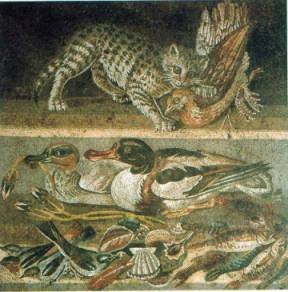Staged hunts
were a parody of reality inspired by the Roman taste for fake and imitation, but there were other shows that were even more fantastic, peculiar of the Roman feeling for nature. In the silvae, painters, technicians and stage architects reconstructed a false scenery in the arena, with trees and bushes made to resemble a forest which was populated by animals, that would not be necessarily massacred.

Romans liked reproduction of nature, like many urban societies did and still do. The same feeling can be found in different times much in the same way. Pastoral poems appealed to the eighteenth century public, and today the same attitude can be found in some TV wildlife programs that feature the animals like actors in a sort of story. The Romans, or at least the citizens of Rome, had forgotten the hard reality of the life in the country, and in a way that today would be branded as mannerist and baroque, loved these fake sceneries.
This aesthetic attitude can also be found in poetry, when Horatius complains about hectic city life and tells us how beautiful is to be in a small house in the country, lighting up the fire to beat the cold, drinking good wine and taking life easy.
Nero had different environments reproduced in his residence: a lake with fake sea villages, false countryside with animals roaming around, and even a nymphaeum, and Hadrian had built an enormous residence near Tibur, today Tivoli, with copies of famous buildings and wonders of the world.
In the novel Satyricon, by Petronius Arbiter, we find the description of a dinner in the villa of an enriched ex-slave, Trimalchio’s, where the animals served at the table were arranged and prepared so as to imitate nature by means of ingenious devices and inventions.

In the silva the country environment was reconstructed with real trees, sometimes dug up with their roots and transplanted. The scenery was probably prepared in the Summum Choragium, which was at first in the area of the temple of Venus and Rome, and after the temple was built was relocated not far, somewhere along modern Via Labicana.
It is easy to think that the scenery could be transported under the arena by underground passages, where it could appear from nothing through the trapdoors on the floor. When the scene was ready, all sorts of exotic animals were released: bears, deers, ostriches, hippos and elephants would wander through woods and bushes, to the delight and amazement of the public.
A less delicate version of the silva was the reconstruction of a mythological scene, in which the “actor”, who was a person condemned to death, really died on the scene. In this case the setting reproduced the scene of a mythological tale, where the end of the hero – mauled by beasts or burned alive – was dramatized but at the same time terribly real, as it was the real death of a man.
